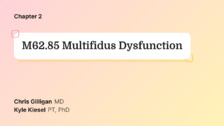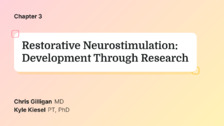Restorative Neuromodulation for Patients With Multifidus
Dysfunction (Recorded Webinar)
Presented by Kyle Kiesel and Christopher Gilligan

12-Month Subscription
Unlimited access to:
- Thousands of CE Courses
- Patient Education
- Home Exercise Program
- And more
This course is a recording of a previously hosted live webinar event. Polling and question submission features are not available for this recording. Format and structure may differ from those of standard Medbridge courses.
Chronic low back pain (CLBP) remains the leading cause of disability worldwide and continues to pose a significant challenge for clinicians. In recent years, rehabilitation providers have encountered updated models and treatment techniques, moving away from traditional interventions focused on motor control and muscle function. A growing body of research has identified a strong link between lumbar multifidus muscle dysfunction and CLBP, challenging the long-standing view that most CLBP is nonspecific. In fact, sufficient evidence has led to the implementation of an ICD-10 code specifically for multifidus dysfunction (M62.85) to guide accurate diagnosis and appropriate treatment.
This webinar will cover the development, supporting evidence, and recommended rehabilitation process for patients with CLBP who receive restorative neuromodulation—an electrical stimulation treatment targeting multifidus dysfunction. The webinar is intended for physical therapists and athletic trainers working in an outpatient setting.
Learning Objectives
- Evaluate treatment options for patients with chronic low back pain (CLBP) to determine the value of restorative neurostimulation for this population
- Determine how lumbar multifidus muscle dysfunction is related to CLBP to create a treatment plan to reduce pain and disability
- Examine current research on restorative neurostimulation to explain its mechanism of action and clinical outcomes to peers and patients
- Implement a patient selection process using physical testing to identify candidates with CLBP for referral to restorative neurostimulation treatment
- Implement an appropriate rehabilitation program for a patient post restorative neurostimulation implant
Meet your instructors

Kyle Kiesel
Dr. Kiesel is a professor of physical therapy at the University of Evansville and a cofounder of the Functional Movement System. During his 20 years in academics, he has spent nine years directing programs in athletic training and physical therapy. His areas of research include motor control of the core, breathing, and…

Christopher Gilligan
Dr. Gilligan’s original training is in emergency medicine, with subspecialty training in pain medicine, where he has focused on pain of spinal origin. Dr. Gilligan’s clinical expertise is focused on the treatment of pain related to disorders of the spine. He also treats patients with a wide range of pain conditions, including…
Chapters & learning objectives

1. Medical Treatment of Axial Chronic Low Back Pain
This chapter introduces common medical algorithms for managing axial chronic low back pain (CLBP), including shortcomings of the current approach. It outlines the origin and rationale behind restorative neurostimulation as an emerging intervention targeting underlying neuromuscular dysfunction.

2. M62.85 Multifidus Dysfunction
This chapter explores the critical role of the lumbar multifidus in core stability and spinal health. It examines how pain can trigger arthrogenic muscle inhibition, leading to multifidus dysfunction characterized by atrophy, fatty infiltration, impaired proprioception, and chronic pain syndromes.

3. Restorative Neurostimulation: Development Through Research
The concept and development of restorative neurostimulation will be presented. Clinical outcomes research on 567 subjects will be discussed, as well as basic science research demonstrating the mechanism of action.

4. Patient Selection and Referral
In this chapter, details of appropriate patient selection for restorative neurostimulation will be covered, including evidence-based physical testing to identify multifidus dysfunction. Appropriate patient referral will be described.

5. Post-implant Rehabilitation Principles
This chapter presents an overview of the key aspects of the rehabilitation process for patients post implant of restorative neurostimulation. Shared goal setting and MSK risk factor management are emphasized.

6. Question and Answer Session
This chapter is a viewer-submitted question and answer session facilitated by Chris Gilligan and Kyle Kiesel.
